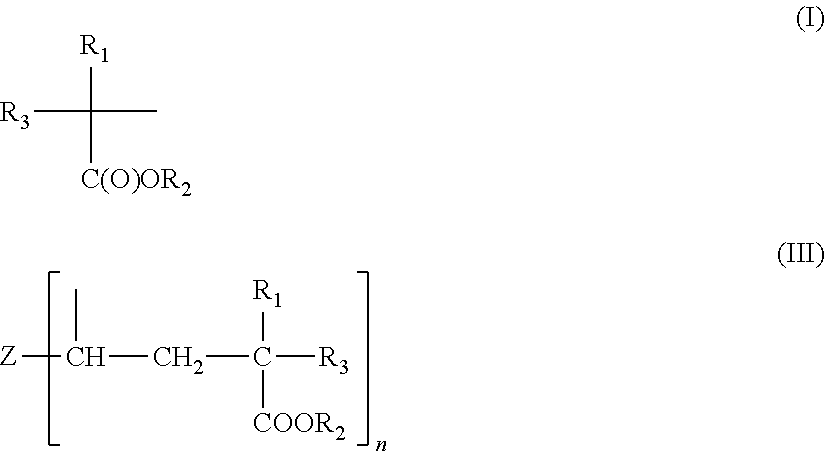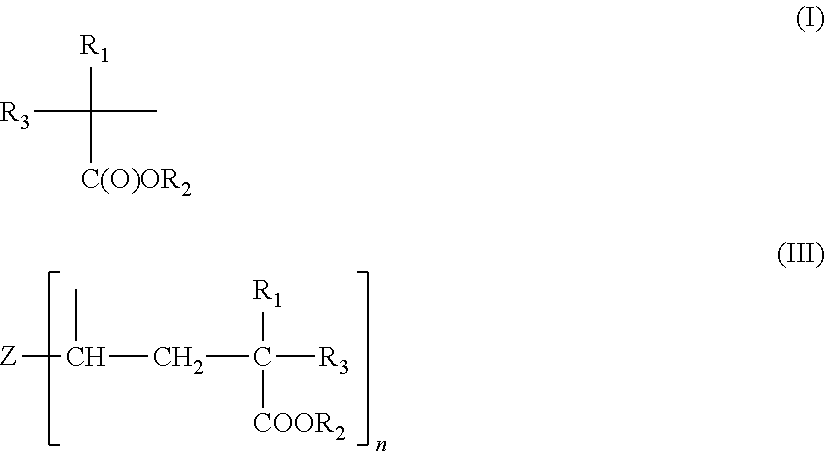METHOD FOR PREPARING pH-INSENSITIVE SURFACTANT FREE POLYMER PARTICLE DISPERSION IN AQUEOUS MEDIUM
- Summary
- Abstract
- Description
- Claims
- Application Information
AI Technical Summary
Benefits of technology
Problems solved by technology
Method used
Image
Examples
example 1
Preparation of 3 kg / mol poly(AMPSNa) Macroinitiator and poly(AMPSNa-b-BA-b-BA / MMA / St) Surfactant-Free Latex
[0059]The following ingredients were weighed into a 2 L stainless steel reactor: 389.29 g of 50 wt % AMPS-Na(aq.), 2.265 g SG1, 481.515 g de-ionized water, 24.805 g BB-MA (obtainable from Arkerna Inc. with offices in Philadelpha, Pa., 6.50×10−2 moles, target Mn≈3.0 kg / mol), and 17.296 g of 20 wt % NaOH(aq.). The mixture is diluted with 178.71 g deionized water and degassed with nitrogen for 10 minutes. The mixture is heated with stirring at 95-105° C. for 4 hours. The product was collected (about 95% cv AMPSNa). The aqueous macroinitiator solution (pAMPSNa) or polymerized-AMPSNa) was used without further purification.
[0060]Into a 2 L stainless steel reactor, 653.2 g de-ionized water, 2.42 g of sodium carbonate and 80.4 g aqueous p(AMPSNa) macroinitiator solution was added. To this homogeneous solution, 16.8 g butyl acrylate (BA) was added. The mixture was bubbled with nitrogen ...
example 2
Preparation of 2.8 kg / mol poly(Hydroxyethyl Acrylate) and poly(Hydroxyethyl Acrylate-b-MMA) Surfactant-Free Latex
[0062]A non-ionic first block was prepared from hydroxyethyl acrylate. 5.0400 g hydroxyethyl acrylate (HEA), 9.949 g de-ionized water, 0.174 g of sodium carbonate, and 0.682 g of BB-MA (1.79×10−3 moles, target Mn≈2.8 kg / mol), were polymerized for 3 hours at 90° C. (98% cv HEA).
[0063]1.2626 g of this low molecular weight aqueous p(hydroxyethyl acrylate) solution was added to a vial with 11.424 g of de-ionized water and 3.514 g MMA. The mixture was polymerized for 1 hour at 100° C., reaching 65% conversion of MMA. Although the particle size was bimodal, the latex was stable.
example 3
Preparation of a poly(AMPSNa-b-BA-b-MMA / BA-Gradient) Triblock Copolymer Surfactant-Free Latex
[0064]50 kg / mol pBA first block was prepared using a 2 kg / mol p(AMPSNa) macroinitiator. To a 2-L Parr high-pressure reactor was charged: 257.7 g de-ionized water, 0.43 g NaHCO3, 35.3 g of 14.4 wt % aqueous p(AMPSNa) macroinitiator solution (5.1 g p(AMPSNa), 2.54×10−3 moles, Mn≈2.0 kg / mol) and 149.5 g butyl acrylate (BA). The reactor was sealed, agitated, sparged with nitrogen and heated at 120° C. until 85% BA conversion was obtained. The reactor was then cooled to room temperature. The latex had 28.4% solids and an intensity-average particle size, DI=130 nm.
[0065]The p(MMA-co-BA) gradient copolymer second block was prepared as follows. 80.5 g methyl methacrylate was added to the above latex. The reactor was sealed, agitated, sparged with nitrogen and heated at 105° C. until reaching 69.5% MMA conversion and 51% conversion of the residual BA. At this point, the latex had 36.9% solids and DI=...
PUM
| Property | Measurement | Unit |
|---|---|---|
| Temperature | aaaaa | aaaaa |
| Dispersion potential | aaaaa | aaaaa |
| Solubility (mass) | aaaaa | aaaaa |
Abstract
Description
Claims
Application Information
 Login to View More
Login to View More - R&D Engineer
- R&D Manager
- IP Professional
- Industry Leading Data Capabilities
- Powerful AI technology
- Patent DNA Extraction
Browse by: Latest US Patents, China's latest patents, Technical Efficacy Thesaurus, Application Domain, Technology Topic, Popular Technical Reports.
© 2024 PatSnap. All rights reserved.Legal|Privacy policy|Modern Slavery Act Transparency Statement|Sitemap|About US| Contact US: help@patsnap.com










